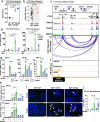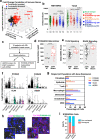ESR1 mutant breast cancers show elevated basal cytokeratins and immune activation
- PMID: 35440136
- PMCID: PMC9019037
- DOI: 10.1038/s41467-022-29498-9
ESR1 mutant breast cancers show elevated basal cytokeratins and immune activation
Abstract
Estrogen receptor alpha (ER/ESR1) is frequently mutated in endocrine resistant ER-positive (ER+) breast cancer and linked to ligand-independent growth and metastasis. Despite the distinct clinical features of ESR1 mutations, their role in intrinsic subtype switching remains largely unknown. Here we find that ESR1 mutant cells and clinical samples show a significant enrichment of basal subtype markers, and six basal cytokeratins (BCKs) are the most enriched genes. Induction of BCKs is independent of ER binding and instead associated with chromatin reprogramming centered around a progesterone receptor-orchestrated insulated neighborhood. BCK-high ER+ primary breast tumors exhibit a number of enriched immune pathways, shared with ESR1 mutant tumors. S100A8 and S100A9 are among the most induced immune mediators and involve in tumor-stroma paracrine crosstalk inferred by single-cell RNA-seq from metastatic tumors. Collectively, these observations demonstrate that ESR1 mutant tumors gain basal features associated with increased immune activation, encouraging additional studies of immune therapeutic vulnerabilities.
© 2022. The Author(s).
Conflict of interest statement
S.Oe and A.V.L. receive research support from AstraZeneca PLC. A.V.L. is employee and consultant with UPMC Enterprises, and member of the Scientific Advisory Board, Stockholder and receives compensation from Ocean Genomics. Tsinghua University paid the stipend of University of Pittsburgh-affiliated foreign scholar Yang Wu from Tsinghua University. D.A.A.V. is cofounder and stock holder of Novasenta, Potenza, Tizona, Trishula; stock holder of Oncorus, Werewolf, Apeximmune; patents licensed and royalties of Astellas, BMS, Novasenta; scientific advisory board member—Tizona, Werewolf, F-Star, Bicara, Apeximmune; consultant of Astellas, BMS, Almirall, Incyte, G1 Therapeutics; research funding of BMS, Astellas, and Novasenta. The remaining authors declare no competing financial interests.
Figures







Similar articles
-
Mutation site and context dependent effects of ESR1 mutation in genome-edited breast cancer cell models.Breast Cancer Res. 2017 May 23;19(1):60. doi: 10.1186/s13058-017-0851-4. Breast Cancer Res. 2017. PMID: 28535794 Free PMC article.
-
Liver tropism of ER mutant breast cancer is characterized by unique molecular changes and immune infiltration.Breast Cancer Res Treat. 2024 Jun;205(2):371-386. doi: 10.1007/s10549-024-07255-4. Epub 2024 Mar 1. Breast Cancer Res Treat. 2024. PMID: 38427312
-
FOXA1 Reprogramming Dictates Retinoid X Receptor Response in ESR1-Mutant Breast Cancer.Mol Cancer Res. 2023 Jun 1;21(6):591-604. doi: 10.1158/1541-7786.MCR-22-0516. Mol Cancer Res. 2023. PMID: 36930833 Free PMC article.
-
ESR1 mutations and therapeutic resistance in metastatic breast cancer: progress and remaining challenges.Br J Cancer. 2022 Feb;126(2):174-186. doi: 10.1038/s41416-021-01564-x. Epub 2021 Oct 7. Br J Cancer. 2022. PMID: 34621045 Free PMC article. Review.
-
ESR1 mutations: Moving towards guiding treatment decision-making in metastatic breast cancer patients.Cancer Treat Rev. 2017 Jan;52:33-40. doi: 10.1016/j.ctrv.2016.11.001. Epub 2016 Nov 10. Cancer Treat Rev. 2017. PMID: 27886589 Review.
Cited by
-
Cancer-cell derived S100A11 promotes macrophage recruitment in ER+ breast cancer.bioRxiv [Preprint]. 2024 Mar 26:2024.03.21.586041. doi: 10.1101/2024.03.21.586041. bioRxiv. 2024. Update in: Oncoimmunology. 2024 Dec 31;13(1):2429186. doi: 10.1080/2162402X.2024.2429186. PMID: 38585952 Free PMC article. Updated. Preprint.
-
CITEgeist: Cellular Indexing of Transcriptomes and Epitopes for Guided Exploration of Intrinsic Spatial Trends.bioRxiv [Preprint]. 2025 Feb 17:2025.02.15.638331. doi: 10.1101/2025.02.15.638331. bioRxiv. 2025. PMID: 40027773 Free PMC article. Preprint.
-
ERα dysfunction caused by ESR1 mutations and therapeutic pressure promotes lineage plasticity in ER+ breast cancer.Nat Cancer. 2025 Feb;6(2):357-371. doi: 10.1038/s43018-024-00898-8. Epub 2025 Jan 13. Nat Cancer. 2025. PMID: 39805955
-
Transforming growth factor-β signalling in tumour resistance to the anti-PD-(L)1 therapy: Updated.J Cell Mol Med. 2023 Feb;27(3):311-321. doi: 10.1111/jcmm.17666. Epub 2023 Jan 10. J Cell Mol Med. 2023. PMID: 36625080 Free PMC article. Review.
-
ESR1 Y537S and D538G Mutations Drive Resistance to CDK4/6 Inhibitors in Estrogen Receptor-Positive Breast Cancer.Clin Cancer Res. 2025 May 1;31(9):1667-1675. doi: 10.1158/1078-0432.CCR-24-2307. Clin Cancer Res. 2025. PMID: 39992682
References
MeSH terms
Substances
Grants and funding
LinkOut - more resources
Full Text Sources
Medical
Molecular Biology Databases
Research Materials
Miscellaneous

